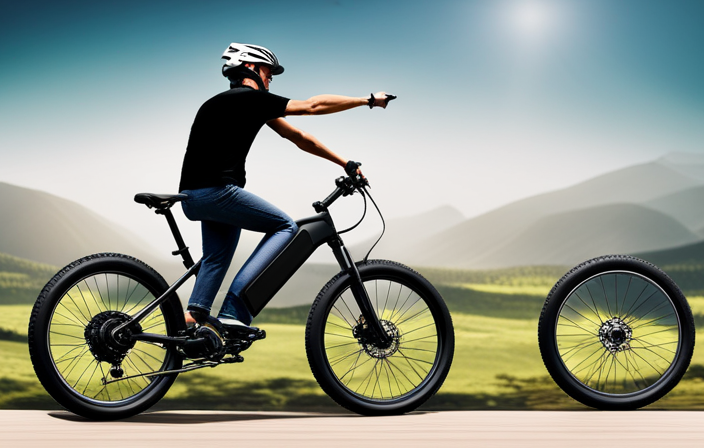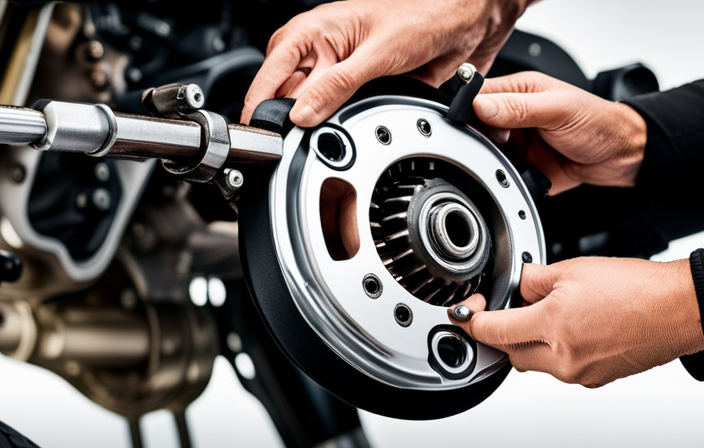As a passionate electric bike lover, I’ve discovered that the battery is the key component of these amazing machines. It acts as the core that drives our journeys and pushes us ahead effortlessly and effectively.
But with so many battery options available, it can be overwhelming to determine which one is right for your electric bike. That’s why in this article, I’ll guide you through the different types of batteries, their pros and cons, and factors to consider when making your decision.
Let’s dive in and find the perfect battery to fuel your electric bike journeys.
Key Takeaways
- Weight and size impact electric bike performance and handling
- Battery lifespan affects cost, longer-lasting batteries save money in the long run
- Use manufacturer-provided charger and avoid third-party chargers for battery maintenance and care
- Consider battery capacity and charging time when choosing a battery
Types of Batteries Used in Electric Bikes
If you’re wondering about the types of batteries used in electric bikes, there are three main options to consider.
These options include lead-acid batteries, nickel-metal hydride (NiMH) batteries, and lithium-ion (Li-ion) batteries. Each type has its own unique characteristics and benefits.
Lead-acid batteries are the most affordable but have limited battery capacity and longer charging times.
NiMH batteries offer a better battery capacity and shorter charging times compared to lead-acid batteries. However, they are heavier and less efficient.
Lastly, lithium-ion batteries are the most popular choice due to their high energy density, lightweight design, and shorter charging times. They offer a longer battery capacity and allow for more extended rides.
Now, let’s dive into the pros and cons of lithium-ion batteries.
Pros and Cons of Lithium-ion Batteries
In my experience, lithium-ion batteries have proven to offer several advantages for electric bikes.
Firstly, they have a higher energy density compared to other types of batteries, meaning they can store more energy in a smaller and lighter package. This allows for longer rides and increased power output.
However, it’s important to note that lithium-ion batteries generally have a shorter lifespan compared to other battery types. Additionally, they tend to be more expensive initially, although the overall cost may be offset by their longer range and performance.
Higher Energy Density
You’ll want to consider batteries with higher energy density for your electric bike. Battery technology has come a long way in recent years, allowing for greater energy storage in smaller and lighter packages. Higher energy density means that the battery can store more energy per unit of volume or weight.
This is especially important for electric bikes, as they rely on battery power for propulsion. With a battery that has higher energy density, you can enjoy longer rides without worrying about running out of power. Additionally, higher energy density batteries can provide more power to the motor, allowing for faster acceleration and better overall performance.
Now, let’s discuss how these batteries also offer a longer lifespan, ensuring that you get the most out of your investment.
Longer Lifespan
Batteries with higher energy density offer a longer lifespan, ensuring you get the most out of them. This is because batteries with higher energy density have more capacity to store and deliver energy, which means they can last longer between charges.
When it comes to battery charging, it is important to follow the manufacturer’s guidelines to avoid overcharging or undercharging, as this can reduce the battery’s lifespan.
Additionally, proper battery storage is crucial for maintaining its lifespan. Storing the battery in a cool, dry place and avoiding extreme temperatures can help prevent degradation and prolong its lifespan.
However, it is important to note that batteries with higher energy density tend to be more expensive. Nonetheless, the longer lifespan they offer makes them a worthwhile investment in the long run.
More Expensive
Although they may be pricier, batteries with higher energy density provide a longer lifespan, making them a worthwhile investment. When it comes to battery performance, it’s important to consider the cost comparison between different options. To illustrate this, let’s take a look at a simple cost comparison table:
| Battery Type | Energy Density (Wh/kg) | Lifespan (cycles) |
|---|---|---|
| High Density | 200 | 1000 |
| Low Density | 100 | 500 |
| Medium Density | 150 | 750 |
As we can see, batteries with higher energy density tend to have a longer lifespan. This means that even though they may be more expensive upfront, they will last longer and provide better overall performance. Now that we understand the importance of battery lifespan and cost, let’s dive into the pros and cons of nickel-metal hydride batteries.
Pros and Cons of Nickel-metal Hydride Batteries
When it comes to electric bikes, nickel-metal hydride (NiMH) batteries have both pros and cons.
NiMH batteries have been widely used in various applications, including electric bikes, due to their high energy density and long cycle life. Compared to lithium-ion batteries, NiMH batteries are generally cheaper and more readily available.
However, they have a lower energy density and tend to be heavier, which can affect the overall performance and range of the electric bike. Additionally, NiMH batteries are more prone to self-discharge and have a shorter shelf life compared to lithium-ion batteries.
Despite these drawbacks, NiMH batteries still offer a cost-effective and reliable option for electric bike owners.
Moving on to the pros and cons of lead-acid batteries…
Pros and Cons of Lead-acid Batteries
After discussing the pros and cons of Nickel-metal Hydride batteries, it’s time to delve into another commonly used battery technology: Lead-acid batteries. These batteries have been around for decades and are known for their affordability and reliability. However, they also have some drawbacks that must be considered before making a decision.
- High capacity: Lead-acid batteries are capable of providing a high amount of power, making them suitable for electric bike applications.
- Low cost: Lead-acid batteries are relatively inexpensive compared to other battery technologies, making them an attractive option for budget-conscious individuals.
- Environmental impact: Lead-acid batteries contain toxic lead and sulfuric acid, which can be harmful to the environment if not properly disposed of.
When choosing a battery for your electric bike, there are several factors to consider.
[Transition Sentence] Let’s now explore the factors to consider when choosing a battery for your electric bike.Factors to Consider When Choosing a Battery
When considering a battery for an electric bike, there are several key factors to take into account.
Firstly, range and power are crucial considerations, as they determine how far and how fast the bike can go on a single charge.
Secondly, weight and size play a significant role, as a heavier and bulkier battery can affect the overall maneuverability and balance of the bike.
Lastly, cost is an important factor to consider, as the price of the battery can vary greatly depending on its capacity and technology.
Range and Power
The battery’s range and power are crucial factors to consider when choosing an electric bike. Battery capacity determines how far you can ride on a single charge, while power determines the bike’s performance and ability to handle steep hills or rough terrain. A higher battery capacity means a longer range, allowing you to ride for extended periods without worrying about running out of power.
Charging time is also an important consideration. Some batteries can be fully charged in just a few hours, while others may take longer. It’s important to choose a battery that suits your needs and lifestyle.
Now, let’s move on to the next section about weight and size, as these factors also play a significant role in choosing the right electric bike.
Weight and Size
Choosing the right electric bike involves considering factors such as weight and size, as they greatly impact the overall riding experience. When it comes to electric bike batteries, the weight and size play a crucial role in determining the performance and handling of the bike. A heavier battery can affect the balance and maneuverability of the bike, making it more difficult to ride. Similarly, a larger battery may take up more space and make the bike bulkier, which can affect its agility and ease of handling. To help you understand the impact of battery weight and size, here is a table that compares different electric bike batteries:
| Battery Type | Weight (lbs) | Size (inches) |
|---|---|---|
| Lithium-ion | 5 | 10x4x3 |
| Nickel-metal hydride | 7 | 8x5x4 |
| Lead-acid | 15 | 12x6x6 |
Considering the battery weight and size is essential to ensure that your electric bike provides a comfortable and enjoyable riding experience. Now, let’s move on to the next section, where we will discuss the cost of electric bike batteries.
Cost
Considering the weight and size of an electric bike battery is crucial in order to ensure a comfortable and enjoyable riding experience. When it comes to the cost of electric bike batteries, there are a few factors to consider. Here are three important points to keep in mind:
-
Battery Lifespan: The lifespan of an electric bike battery is an important consideration when looking at cost. Longer-lasting batteries may have a higher upfront cost, but they can save you money in the long run by needing fewer replacements.
-
Performance: The cost of an electric bike battery can also be influenced by its performance capabilities. Higher-performance batteries with greater power output and longer range may come at a higher price, but they can provide a more satisfying riding experience.
-
Cost vs Performance Trade-off: When choosing an electric bike battery, it’s important to strike a balance between cost and performance. Consider your specific needs and budget to find a battery that offers good value for money.
Taking all these factors into account, it’s important to consider battery maintenance and care tips to ensure the longevity and optimal performance of your electric bike battery.
Battery Maintenance and Care Tips
To ensure your electric bike battery lasts longer, make sure you follow these maintenance and care tips.
-
When it comes to charging your battery, it’s important to use the charger provided by the manufacturer and avoid using third-party chargers. This will ensure that the battery is charged correctly and prevent any damage. Additionally, it’s recommended to charge the battery fully before each use and avoid leaving it plugged in for extended periods of time.
-
When storing your battery, make sure it is kept in a cool and dry place, away from extreme temperatures. It’s also a good idea to charge the battery to around 50% before storing it for long periods.
By following these battery charging and storage tips, you can extend the lifespan of your electric bike battery.
Now, let’s move on to discussing recommended battery brands and models.
Recommended Battery Brands and Models
Now, let’s take a look at some recommended brands and models for your battery needs.
When it comes to battery capacity and charging time, there are a few standout options in the market.
One popular choice is the Bosch PowerTube 500. With a capacity of 500Wh, it offers a decent range for your electric bike. It also has a relatively quick charging time, allowing you to get back on the road faster.
Another reliable brand is Shimano, known for their high-quality batteries. The Shimano STEPS BT-E8010 is a great option with a capacity of 504Wh and a fast charging time.
For those looking for a more budget-friendly option, the Enerpower Deluxe is worth considering. It has a capacity of 468Wh and offers decent charging time.
These brands and models provide reliable battery performance, ensuring a smooth and efficient ride.
Now, let’s move on to how to extend battery life without compromising your cycling experience.
How to Extend Battery Life
One way to maximize the lifespan of your battery is by practicing efficient charging habits. By understanding how to properly charge your battery, you can extend its life and maximize its performance. Here are some tips to help you get the most out of your battery:
| Efficient Charging Habits |
|---|
| Avoid overcharging |
| Charge at moderate temperatures |
| Use the manufacturer’s recommended charger |
| Avoid deep discharges |
| Store your battery properly when not in use |
Understanding Battery Warranty and Replacement
After learning about how to extend the battery life of an electric bike, it is important to understand the warranty and replacement options for the battery.
When purchasing an electric bike, it is crucial to inquire about the battery warranty. Most manufacturers offer a warranty period for the battery, which typically ranges from one to three years. This warranty ensures that the battery will perform optimally without any defects or malfunctions.
In the event that the battery fails within the warranty period, the manufacturer will replace it free of charge. However, it is essential to read the warranty terms and conditions to understand what is covered and what is not.
If the battery fails outside the warranty period, it will be necessary to purchase a new one. When replacing the battery, it is crucial to choose a battery that is compatible with the electric bike model and has similar specifications.
Now that we understand the battery warranty and replacement options, let’s move on to the conclusion and final recommendations.
Conclusion and Final Recommendations
To wrap things up, it’s crucial for you to consider these final recommendations before making your decision.
When it comes to choosing the right battery for your electric bike, two important factors to consider are battery capacity and charging time.
Battery capacity refers to the amount of energy the battery can store, and it is measured in ampere-hours (Ah). The higher the battery capacity, the longer your electric bike can run before needing a recharge.
Charging time, on the other hand, refers to the time it takes for the battery to fully recharge. It is important to choose a battery with a reasonable charging time so that you don’t have to wait too long before using your electric bike again.
Frequently Asked Questions
How much does an electric bike battery typically cost?
An electric bike battery typically costs between $200 and $1000. The cost is influenced by factors such as battery capacity, brand reputation, and technology used. Comparing prices and considering these factors will help determine the best value for your needs.
Are there any safety precautions I should take when handling electric bike batteries?
When handling electric bike batteries, it is crucial to prioritize safety precautions. Proper handling includes wearing protective gear, avoiding contact with water or extreme temperatures, and storing the battery in a cool, dry place.
Can I use any type of battery charger for my electric bike battery?
You should use a compatible battery charger for your electric bike battery to ensure proper charging and avoid damage. While alternative options may exist, it is important to verify compatibility to prevent potential issues.
How long does it take to fully charge an electric bike battery?
On average, it takes around 3-4 hours to fully charge an electric bike battery with a standard charger. The charging time may vary depending on the battery’s capacity, with larger capacity batteries taking longer to charge.
Can I use a different brand or model of battery for my electric bike?
Yes, you can use alternative battery options for your electric bike. However, it is important to consider compatibility issues with different brands or models. Ensure that the voltage, capacity, and connector type are suitable for your bike’s system.
Conclusion
In conclusion, after careful consideration and evaluation of various battery options for electric bikes, it is clear that the lithium-ion battery stands out as the most superior choice.
With its high energy density, longer lifespan, and lightweight design, it provides the best performance and efficiency.
While nickel-metal hydride and lead-acid batteries have their own advantages, they cannot match the overall superiority of lithium-ion batteries.
Therefore, I highly recommend opting for a lithium-ion battery to power your electric bike and enjoy a thrilling and long-lasting ride.
Remember, with the right battery, your electric bike will soar like a majestic eagle through the streets.
















